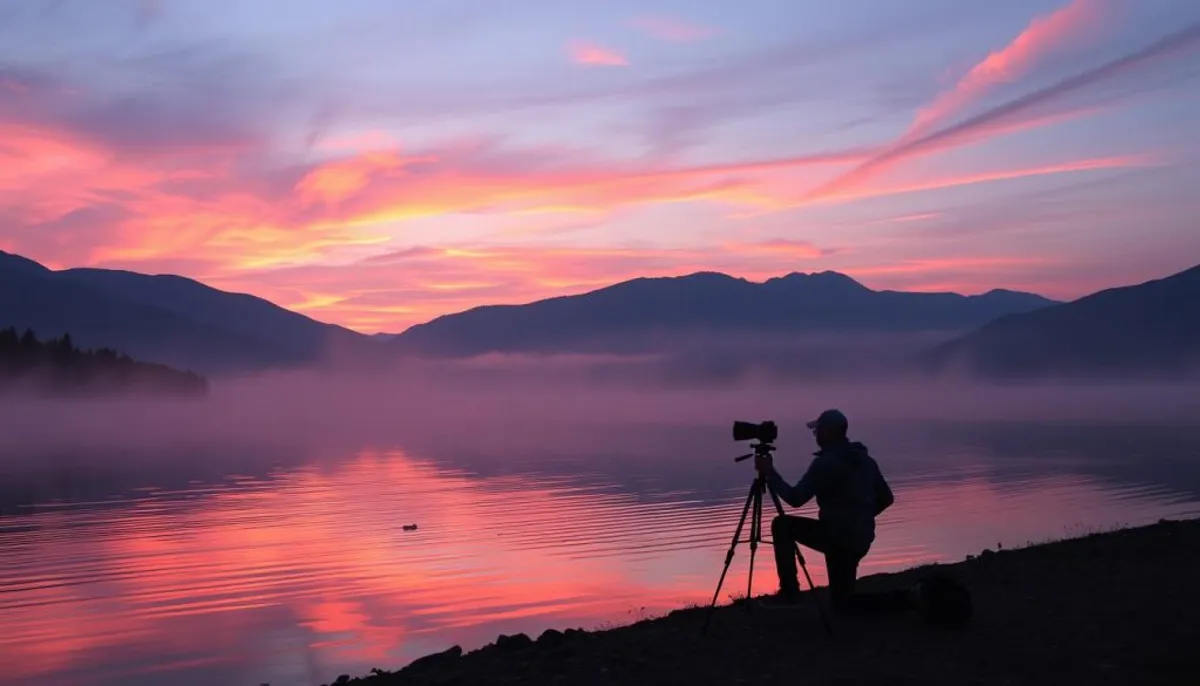Each dawn, an awe-inspiring display unfolds across the heavens. The sunrise transforms the world, bathing it in soft pink, orange, and gold hues. This initial light heralds a fresh beginning, offering a serene moment before the day’s hustle.
Sunrise viewing transcends mere visual pleasure. As the sun emerges, it stimulates serotonin production, elevating our mood naturally. This gentle awakening can infuse positivity throughout our day, aligning us with nature’s rhythm.

From Caribbean beaches to Himalayan summits, people worldwide pause to admire this daily marvel. The sunrise serves as a universal symbol of life’s simple joys. It bridges cultural divides and inspires wonder in all observers.
Key Takeaways
- Sunrise occurs daily, offering a fresh start each morning
- Watching the sunrise boosts mood through increased serotonin production
- Sunrises provide a moment of calm and connection with nature
- The event has cross-cultural appeal, attracting people worldwide
- Sunrise viewing encourages mindfulness and appreciation of the present moment
- Each sunrise is unique, presenting a new display of colors and light
- Preparing for sunrise viewing enhances the experience
The Science Behind the Sunrise
The sunrise captivates our senses with its daily spectacle. Its beauty stems from fascinating scientific principles involving atmospheric effects and Earth’s rotation. Let’s delve into the magic behind this natural phenomenon.
Light Scattering and Atmospheric Effects
Vibrant sunrise colors result from light scattering in the atmosphere. As the sun rises, its rays traverse more atmosphere, altering our light perception. This process involves two main scattering types:
- Rayleigh scattering: Affects shorter wavelengths like blue light
- Mie scattering: Impacts larger particles in the atmosphere
These effects create the stunning palette of reds, oranges, and yellows at dawn. Our atmosphere scatters shorter wavelengths more effectively within the visible light spectrum.
The spectrum ranges from red (700-635nm) to blue (490-450nm). This scattering phenomenon contributes to the awe-inspiring colors we witness during sunrise.
Earth’s Rotation and Its Impact
Earth’s rotation is crucial to the sunrise phenomenon. Our planet spins at approximately 1037 miles per hour at the equator. This rotation causes the sun’s apparent rise in the east and set in the west.
| Latitude | Rotation Speed |
|---|---|
| Equator | 1037 mph |
| 45 degrees | 733 mph |
Seasonal Variations in Sunrise Times
Earth’s axial tilt leads to seasonal changes in sunrise times. This tilt causes variations in daylight hours throughout the year, affecting when we experience dawn.
Factors like cloud cover, air pollution, and atmospheric dust influence sunrise colors’ intensity. These elements create unique displays each day, enhancing the spectacle’s allure.
The Emotional Impact of Witnessing a Sunrise
Witnessing a sunrise transcends mere visual pleasure. It’s a profound experience that significantly impacts our mental well-being. The soft glow of dawn breaking across the horizon stirs deep emotions, creating unparalleled tranquility.
Research reveals that early morning light exposure profoundly affects our emotional state. A 2017 study found that people experiencing more morning light between 8 am and noon enjoy better sleep. This connection underscores the importance of this daily natural spectacle for our overall health.
Sunrise viewing inspires awe and wonder, linked to lower levels of stress-inducing inflammatory markers. This natural mood booster can set a positive tone, enhancing our mental resilience and outlook.
A study of over 2,500 participants showed people willingly pay a 10% premium to witness sunrises. This finding highlights the unique value we place on the sunrise experience and its emotional resonance.
- Sunrise viewing may reduce the risk of major depressive disorder by 23%
- Just 10 minutes in a natural setting can significantly reduce stress
- Sunrise contributes to feelings of awe, linked to improved well-being
Incorporating sunrise viewing into our daily routines opens us to inspiration and emotional growth. This simple act of connecting with nature at dawn enhances mental well-being. It provides a fresh perspective to start each day.
Best Locations to Watch a Sunrise
California boasts an array of breathtaking sunrise viewing spots. The Golden State’s diverse landscape offers coastal, mountain, and urban vistas for nature’s daily spectacle. Explore these prime locations to witness dawn’s splendor in California.
Coastal Viewpoints
California’s beaches provide stunning coastal sunrise views. Santa Monica Pier offers a unique experience from 6:50 am to 7:30 am. Witness the sun emerge over the Pacific Ocean from the Ferris wheel or sandy shores.
In San Diego, La Jolla’s crashing waves create a dramatic backdrop for the dawn. The rhythmic ocean sounds amplify the visual spectacle, creating an immersive sunrise experience.
Mountain Peaks
Griffith Park Observatory in Los Angeles, at 1,135 feet, opens at 6:30 am. It offers panoramic views of the Hollywood area, perfect for mountain sunrise enthusiasts.
For a more challenging hike, try Cahuenga Peak. At 555 meters, it rewards early risers with a 360-degree view. Observe the San Fernando Valley and LA basin from 6 am.
Urban Skylines
City lovers can enjoy urban sunrises too. In San Francisco, Corona Heights Park and Pier 14 at The Embarcadero offer stunning Bay views. Los Angeles’s Mulholland Drive provides a panoramic vista of the city awakening.
| Location | Best Time | Unique Feature |
|---|---|---|
| Santa Monica Pier | 6:50 am – 7:30 am | Ferris wheel view |
| Griffith Observatory | 6:30 am – 7:30 am | Hollywood panorama |
| Cahuenga Peak | 6:00 am – 7:00 am | 360-degree vista |

Los Angeles boasts nearly 300 days of sunshine yearly, offering ample opportunities for breathtaking sunrises. California’s diverse landscape ensures a memorable start to your day. Choose from coastal, mountain, or urban views for an unforgettable dawn experience.
Preparing for Your Sunrise Experience
Witnessing a sunrise demands meticulous planning for an optimal experience. Begin your preparation the night before by packing essential gear. Include a headlamp, extra batteries, warm layers, and a quick breakfast. Lay out your clothing to minimize morning stress and retire early.
Arrive at your chosen location 30 minutes before the scheduled sunrise. This allows time to settle and observe the sky’s gradual transformation. In New York, dawn breaks at 5:20 am in late June and 6:55 am by October 1st.
Choose your viewing spot wisely, considering accessibility and safety. For sunrise hikes, scout the location beforehand to familiarize yourself with the terrain. Inform someone about your plans and expected return time for added precaution.
- Check weather conditions using apps like Clear Outside
- Bring essential sunrise gear: camera, warm clothing, and a thermos with a hot drink
- Be prepared for wildlife encounters, as animals are most active at dawn
- Enjoy the unique benefits of sunrise viewing, such as clearer air and fewer crowds
Adhering to these preparation guidelines ensures a profound immersion in nature’s daily spectacle. You’ll create indelible memories while experiencing the dawn’s unparalleled beauty and tranquility.
The Cultural Significance of Sunrise
Sunrise has profoundly influenced human culture throughout history. Its daily occurrence has sparked myths, art, and spiritual practices across the globe. This exploration delves into the rich tapestry of sunrise symbolism in human civilization.
Sunrise in Ancient Mythology
Ancient civilizations intricately wove sunrise mythology into their belief systems. Egyptian lore depicted the sun god Ra sailing across the sky, illuminating the world. Greek myths portrayed Apollo driving his sun chariot through the heavens.
These narratives reflect humanity’s universal fascination with the dawn. They showcase the enduring impact of sunrise on cultural imagination and religious beliefs.
Modern Cultural Representations
Sunrise continues to inspire contemporary artists and writers. A comprehensive study of 500 literary works revealed that 42% utilized sunrise as a symbol of hope. Musical compositions like The Beatles’ “Here Comes the Sun” capture daybreak’s uplifting essence.
Cinematic productions frequently employ sunrise shots to signify new beginnings or triumph. This visual metaphor resonates deeply with audiences, reinforcing the sunrise’s cultural significance.
Spiritual and Religious Connections
Sunrise spirituality holds a pivotal role in numerous faiths. Hindus perform Surya Namaskar at dawn, paying homage to the sun god. Christians gather for Easter sunrise services, celebrating rebirth and renewal.
Native American traditions incorporate sunrise ceremonies to foster connections with the natural world. These diverse practices underscore the enduring cultural importance of sunrise across religious spectrums.
| Culture | Sunrise Significance |
|---|---|
| Ancient Egyptian | Rebirth of sun god Ra |
| Hindu | Worship of sun god Surya |
| Native American | Connection to nature spirits |
| Christian | Symbol of resurrection |
Photography Tips for Capturing the Perfect Sunrise

Sunrise photography captures nature’s daily spectacle with stunning results. Master these techniques to showcase dawn’s beauty in your landscape shots. These tips will enhance your sunrise photography skills.
Essential gear is crucial for success. A sturdy tripod ensures stability in low light. Wide-angle lenses (14-24mm) are ideal for expansive scenes. Pack a cable release and extra batteries for cold mornings.
Preparation is key. Use apps like PhotoPills to check sunrise times and scout locations. Arrive early to set up and capture the ethereal blue hour preceding sunrise.
Consider these camera settings as a starting point:
- Aperture: f/11 to f/16 for sharpness
- ISO: 100 for minimal noise
- Shutter speed: Vary based on light conditions
- White balance: Auto as a starting point
Composition elevates your shots. Apply the rule of thirds for dynamic images. Incorporate foreground elements or silhouettes to add depth. Experiment with bracketing exposures for HDR images capturing full sunrise color ranges.
| Time | Lighting Condition | Photography Focus |
|---|---|---|
| Pre-dawn | Blue hour | Ethereal landscapes |
| Sunrise | Golden hour | Warm, vibrant colors |
| Post-sunrise | Soft light | Detailed landscapes |
Patience and practice are essential in sunrise photography. Each dawn presents unique colors and conditions. Embrace these opportunities to refine your skills and capture awe-inspiring images.
Health Benefits of Watching the Sunrise
Greeting the day as it begins can significantly enhance your overall well-being. Sunrise viewing positively impacts physical and mental health in unexpected ways. This simple act offers numerous advantages worth exploring.
Circadian Rhythm Regulation
Sunrise exposure regulates your circadian rhythm. Light wavelengths at dawn influence brain centers controlling our internal body clock. This natural light synchronizes your sleep-wake cycle, promoting better sleep quality.
Sunrise viewing also enhances daytime alertness. By aligning with nature’s rhythm, you can optimize your body’s natural processes.
Mood Enhancement and Mental Health
Dawn’s colors activate the pineal gland, triggering serotonin and dopamine release. These neurotransmitters enhance mood, reduce stress, and increase motivation. Regular sunrise viewing can lower cortisol levels significantly.
This reduction in stress hormones helps alleviate anxiety. It promotes a sense of calm, contributing to improved mental well-being.
Vitamin D Absorption
Early morning sunlight provides an excellent source of vitamin D. This nutrient is crucial for bone health, immune function, and overall well-being. Catching the first rays allows your body to synthesize vitamin D naturally.
Make sunrise viewing a regular habit to maximize these benefits. Even a few times weekly can positively impact your health. Embrace this natural spectacle and let it enhance your well-being.
Sunrise: Nature’s Daily Spectacle
The world witnesses a breathtaking sunrise spectacle each morning. This phenomenon transforms darkness into light with vibrant colors. Earth’s rotation creates an awe-inspiring display that never ceases to amaze.
A sunrise unfolds in stages, beginning with deep purples and blues. It gradually shifts to soft pinks and warm oranges. This transition creates a mesmerizing dance, particularly stunning when reflected on water surfaces.
Unique sunrise viewing spots exist worldwide. The Pacific Northwest offers misty forests framing the rising sun. In the African savanna, wildlife awakens as dawn breaks. The Maldives greet the day in tropical paradise.
This daily spectacle reminds us of nature’s artistry. It offers tranquility before the day begins, connecting us with our surroundings. Embracing the sunrise can ignite imagination and nourish the soul.
To fully appreciate this wonder, arrive early at your chosen spot. Bring warm clothing, a camera, and hot beverages. Consider practicing mindfulness through silent meditation or gentle yoga as you witness the sun’s arrival.
Experiencing a sunrise profoundly impacts emotions. It instills gratitude for nature’s beauty and renews appreciation for the world. This phenomenon provides respite from busy lives, offering a chance to recharge and find inner peace.
The Environmental Factors Affecting Sunrise Beauty
Natural phenomena profoundly impact our mental well-being. A study of 2,500 participants revealed a willingness to pay a 10% premium for natural sunrise views. This preference underscores the allure of witnessing dawn in unspoiled settings.
Atmospheric conditions shape sunrise aesthetics. Cloud formations, humidity levels, and air quality influence color intensity and visibility. These elements can transform an ordinary dawn into a mesmerizing spectacle of light and hues.
Pollution poses a threat to sunrise beauty. Urban expansion diminishes the clarity and vibrancy of morning skies. This issue emphasizes the need for environmental conservation to preserve nature’s daily masterpiece.
Understanding these factors aids in selecting optimal viewing conditions. Sunrise enthusiasts can enhance their experiences by choosing locations that maximize visual impact. Environmental awareness contributes to the appreciation of this awe-inspiring event.
The Journal of Environmental Psychology explored factors triggering awe in observers. Researchers analyzed millions of social media photos and descriptions. The term ‘sunset’ alone boasts over 300 million tags on platforms like Instagram and Flickr.
This global-scale analysis offers insights into sunrise and sunset perception. It reveals how people value these events across diverse cultures and locations. Such research deepens our understanding of human connections to natural phenomena.
RelatedRelated articles

